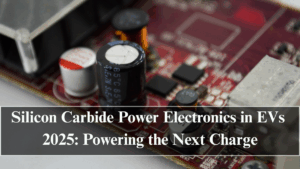The year 2025 marks a defining moment for electric mobility, and at the core of this transformation lies a breakthrough in semiconductor technology — Silicon Carbide (SiC) power electronics. As electric vehicles (EVs) evolve to deliver higher range, faster charging, and improved performance, automakers are moving away from traditional silicon transistors toward silicon carbide systems that can handle greater voltages, generate less heat, and enable ultra-efficient energy conversion.
Silicon Carbide Power Electronics in EVs 2025 are revolutionizing how power flows between the battery, motor, and charging infrastructure. These advanced semiconductors reduce energy loss during conversion, meaning more of the stored power in a battery goes directly to the wheels. The result: longer range, quicker acceleration, and significantly faster charging times—all essential in making electric vehicles the preferred choice for the next generation of drivers.

What Is Silicon Carbide and Why It Matters
Silicon carbide (SiC) is a compound of silicon and carbon that exhibits exceptional electrical and thermal properties. Compared to traditional silicon-based transistors, SiC devices can operate at higher voltages and temperatures while maintaining superior efficiency. This makes them ideal for use in high-performance EV systems such as traction inverters, onboard chargers, and DC fast-charging units.
While conventional silicon semiconductors tend to lose efficiency under stress, SiC maintains performance even in extreme heat. This means EVs can operate at higher voltages—up to 800V architectures—which translates into faster charging and smaller, lighter power components. As EV manufacturers push for compact designs and longer battery life, silicon carbide has become a key enabler of next-generation mobility.
How Silicon Carbide Boosts EV Performance
The integration of silicon carbide power electronics enhances every aspect of an EV’s performance. Inverters built with SiC transistors convert DC power from the battery into AC power for the motor with minimal loss, increasing energy efficiency by nearly 10%. This not only extends range but also reduces cooling requirements since less heat is generated.
Additionally, silicon carbide enables ultra-fast charging speeds, allowing EVs to reach 80% charge in under 15 minutes at high-voltage stations. Automakers like Tesla, Porsche, and Hyundai are already deploying SiC modules to achieve superior energy conversion efficiency and dynamic power delivery. By 2025, over half of premium electric vehicles are expected to incorporate SiC-based power modules in their design.
Manufacturing and Cost Trends
One of the early challenges for silicon carbide adoption was its cost. Producing SiC wafers requires complex crystal growth techniques that were initially expensive compared to silicon. However, recent advances in manufacturing have lowered costs by more than 40%, making SiC components increasingly accessible for mass-market EVs.
Leading semiconductor companies such as Wolfspeed, Infineon, and STMicroelectronics have invested heavily in expanding SiC production capacity. Their partnerships with automakers ensure steady supply chains for large-scale deployment. As economies of scale improve, even mid-range EVs will soon benefit from this high-efficiency technology, narrowing the performance gap between luxury and mainstream electric vehicles.
Impact on Charging Infrastructure and Energy Efficiency
Silicon Carbide Power Electronics in EVs 2025 extend beyond vehicle design—they also redefine the entire charging ecosystem. SiC technology enables high-power DC chargers that are smaller, more efficient, and capable of handling grid-to-vehicle energy transfers with minimal loss. This efficiency plays a vital role in building sustainable charging infrastructure by reducing the overall power demand per vehicle.
Moreover, silicon carbide converters are key to enabling bidirectional charging (vehicle-to-grid systems), where EVs can return energy to the grid or power homes. With their ability to operate at higher voltages, SiC-based systems improve the reliability of such smart energy applications, paving the way for integrated energy networks that link transportation and home electricity seamlessly.
Sustainability and the Future of SiC in Mobility
Apart from performance benefits, silicon carbide contributes directly to sustainability goals. The reduction in energy waste means EVs require fewer charging cycles, which helps extend battery lifespan and reduce carbon footprint over time. As automakers shift toward full electrification, SiC devices will play a central role in meeting zero-emission targets by improving system-level efficiency from production to road use.
By 2030, industry analysts predict that nearly every new EV platform will include SiC-based power electronics as standard. The technology’s scalability across applications—from compact city cars to heavy-duty trucks—will make it a cornerstone of global electrification. In essence, silicon carbide is not just a component; it’s the invisible power behind the electric revolution.
FAQs
What are Silicon Carbide Power Electronics in EVs?
They are advanced semiconductor components made from silicon carbide that manage and convert electrical power in EV systems with higher efficiency and lower energy loss.
How do SiC devices improve EV performance?
They allow faster charging, better heat resistance, and higher voltage operation, improving overall efficiency, range, and reliability of electric vehicles.
Why is silicon carbide better than traditional silicon?
SiC can operate at higher temperatures and voltages, offering greater energy efficiency, reduced component size, and improved durability.
Are SiC components expensive?
While initially costly, manufacturing advancements and mass production have significantly reduced SiC component prices, making them viable for mainstream EVs.
What is the future of SiC technology in EVs?
By 2030, most electric vehicles and charging networks will use silicon carbide systems to achieve ultra-fast charging and sustainable power efficiency.
Click here to know more.
